 Roger’s
Comments
(group member since Aug 29, 2018)
Roger’s
Comments
(group member since Aug 29, 2018)
Roger’s
comments
from the Ovid's Metamorphoses and Further Metamorphoses group.
Showing 41-60 of 419
 Jim wrote: "I don't recall Hughes having included this scene...."
Jim wrote: "I don't recall Hughes having included this scene...."Hughes handles the Proserpina story very nicely. He writes mostly in five-line stanzas, but these are flexible enough to suit the needs of the moment. And when he comes to the key moments in the story, he expands the Ovid with delightful irregularity:
Proserpina was playing in that glade
With her companions.
Brilliant as butterflies
They flitted hither and thither excitedly
Among lilies and violets. She was heaping
The fold of her dress with the flowers,
Hurrying to pick more, to gather most,
Piling more than any of her friends into baskets.
There the Lord of Hell suddenly saw her.
In the sweep of a single glance
He fell in love
And snatched her away—
Love pauses for nothing.
 Ce Ce wrote: "Elena wrote: "The Berkeley Rep will be performing Metamorphoses by Mary Zimmerman January 24 to March 10 , 2019."
Ce Ce wrote: "Elena wrote: "The Berkeley Rep will be performing Metamorphoses by Mary Zimmerman January 24 to March 10 , 2019."Thanks for that magazine. I'm pleased to see that this revival is being directed by MZ herself. My brief experience with her work is that the genius is less in the script than in what she does with it. I wish I could see it, but from Baltimore even Minneapolis is too far. R.
 You're right, Jim. The stories Hughes chooses from this book are Proserpina and Arethusa. The After Ovid collection has the opening slaughter scene, Pyreneus and the Muses, Proserpina's pomegranate, and Ascalaphus. I'll probably post some samples later.
You're right, Jim. The stories Hughes chooses from this book are Proserpina and Arethusa. The After Ovid collection has the opening slaughter scene, Pyreneus and the Muses, Proserpina's pomegranate, and Ascalaphus. I'll probably post some samples later.Right now, I'm struggling with that index, and discovering that I have forgotten some of what I did in compiling the code! Should be up by
 Kalliope wrote: "I cannot imagine many paintings coming out of the initial battle scene…"
Kalliope wrote: "I cannot imagine many paintings coming out of the initial battle scene…"There are a few (or perhaps from the later part of the battle). But they all tend to be large-scale heroic, with none of the parody that Roman Clodia finds in Ovid, and certainly none of the wit of your sculpture-gallery aftermath! Here are four, most of them from the later baroque (I wonder why?).
Annibale Carracci (1560–1609) used the subject for one of his frescoes in the Palazzo Farnese; I especially like his use of monochrome for the figures who have already been turned to stone. It seems the transformation was instant; look at the gilded table, which is seen at the moment of being knocked over. There is a painting by Luca Giordano (1634–1705) in London. I can't find a good color reproduction of the whole thing, but the detail shows us what we are missing. Then one by Sebastiano Ricci (1659–1734), and an 18th-century rendering, the grandest of the lot, by Jean-Marc Nattier (1685–1766). Nattier's title and composition emphasize that all this is presided over by Minerva, a fact that I don't recall from Ovid. The added vertical element does make a change, though, from the basically horizontal action of all the others. R.

Carracci: Perseus and Phineus (1597, Rome, Galleria Farnese)
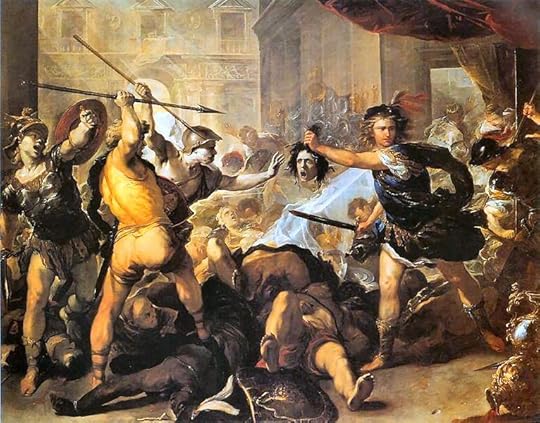
Giordano: Perseus turning Phineas and his Followers to Stone (early 1680s, London NG)

— detail of the above

Ricci: Perseus Confronting Phineus with the Head of Medusa (1705–10, LA Getty)

Nattier: Perseus, under the Protection of Minerva, Turns Phineus to Stone (C18, Tours)
 Kalliope wrote: "We come to another major subject for artists,..."
Kalliope wrote: "We come to another major subject for artists,..."I too am struck by that Pieter Brueghel II and its Boschlike atmosphere. The horses in the one by Jan Brueghel are rather splendid too; I wonder if they were an inspiration for the painting by Ulpiano Checa I posted just now in #45? R.
 MORE PROSERPINAE. I happened to have a few of these on hand, since I teach a class on artists' responses to the turning seasons, which is of course the central truth of the Persephone myth. A couple more turned up as I was searching.
MORE PROSERPINAE. I happened to have a few of these on hand, since I teach a class on artists' responses to the turning seasons, which is of course the central truth of the Persephone myth. A couple more turned up as I was searching. Two are antique: a fresco from a tomb in Virgina, and an Imperial Roman sarcophagus from my own local museum:

Greek: Pluto and Persephone (detail from a tomb fresco in Vergina, c.340 BCE)

Roman: Abduction of Proserpina (sarcophagus, 200–225 CE, Baltimore, Walters)
Then on to easel paintings. Two by our frequent heroes: Rubens from the Torre de la Parada series, giving great prominence to I suppose Ceres (though why is she so martial?), and Rembrandt in his relatively early phase when he was painting mythological subjects (as also the Europa) in great detail set in a murky landscape. And framing them, an early version by Niccolò dell'Abate (c.1510–71), who gets in a lot of the detail of the Ovid, and a later close-up by Simone Pignoni (1611–98), whose sinister shadows are really rather marvelous:

Dell'Abate: Hades Seizes Persephone (1560s, Louvre)

Rembrandy: The Rape of Persephone (1631, Berlin)
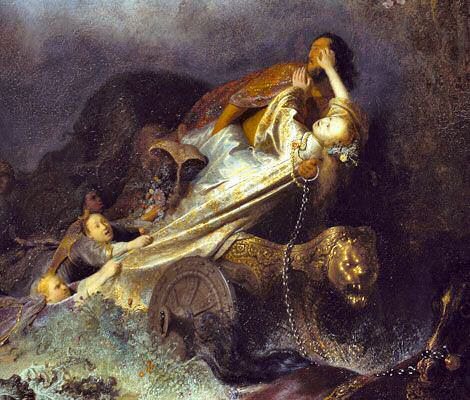
— detail of the above

Rubens: The Rape of Persephone (1636–38, Prado)
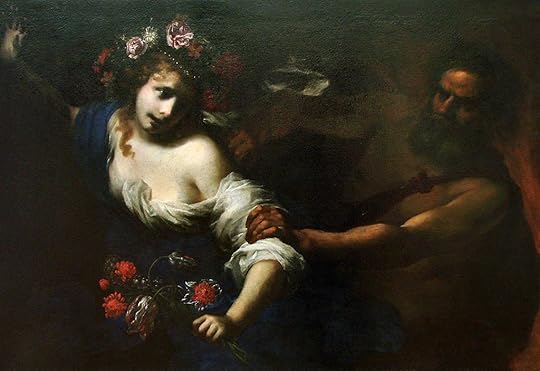
Pignoni: The Rape of Proserpine (c.1650, Nancy)
Finally two from the late 19th century that are strikingly different in mood. I had not heard of the Spanish painter Ulpiano Checa (1860–1916), but see that he was something of a specialist in horses, which he uses to great effect here. And Frederic Leighton (1830–96) again, painting the happy ending of the story. R.

Checa: The Rape of Persephone (1888)

Leighton: The Return of Persephone (1891, Leeds)
 Kalliope wrote: "We come to another major subject for artists.
Kalliope wrote: "We come to another major subject for artists. Jim already mentioned Bernini's. Here is the complete sculpture."
It has always struck me how much better this sculpture looks in close-up than complete. The fussy decoration of that room in the Galleria Borghese and the lovely clean lines of the Bernini clash horribly. The camera (and human eye) can separate them close up, but not at a distance.
The paintings are quite varied in approach, aren't they? I may have a couple more to post. It is interesting how many times Ovid subjects crop up among the English Pre-Raphaelites; I wonder why that is? R.
 I just looked at the Latin. There are seven lines in quotes, which do indeed seem to be in a more jingly kind of meter. But then I was looking for it; I'm not at all sure I would have seen it otherwise.
I just looked at the Latin. There are seven lines in quotes, which do indeed seem to be in a more jingly kind of meter. But then I was looking for it; I'm not at all sure I would have seen it otherwise.But only seven lines; Martin has sixteen. It would seem that he, like Ted Hughes elsewhere, feels free to expand on Ovid's ideas when the mood takes him. He is clearly having fun with the girls' challenge to the "poetry slam"! R.
 I have been reading this in the Martin translation. When telling the story of the Pierides, he suddenly breaks into contemporary slang—it might almost be rap. Is there any equivalent of this in the Latin? [I could check, but I'm not sure I would recognize any shift in tone.] Anyway, here's how Martin starts:
I have been reading this in the Martin translation. When telling the story of the Pierides, he suddenly breaks into contemporary slang—it might almost be rap. Is there any equivalent of this in the Latin? [I could check, but I'm not sure I would recognize any shift in tone.] Anyway, here's how Martin starts:We'll show you girls just what real class is…and so on, without any end-of-line punctuation, ending:
Give up tryin' to deceive the masses
Your rhymes are fake: accept our wager
Learn which of us is minor and which is major
There's nine of us here and there's nine of you
And you'll be nowhere long before we're through
Nothin's gonna save you 'cuz your songs are lame
And the way you sing 'em is really a shame
So take the wings off, sisters, get down and jam
And let the nymphs be the judges of our poetry slam!
 I'm just resurfacing after not just that other project (which of course went on longer than I expected) but also a bout with flu—all now happily in the past. I will make time to look at all this in more detail, enjoy the many images, and perhaps add to them. But first, I need to bring my index up to date, especially all the artwork that was posted on Book IV. I hope to have that done tomorrow.
I'm just resurfacing after not just that other project (which of course went on longer than I expected) but also a bout with flu—all now happily in the past. I will make time to look at all this in more detail, enjoy the many images, and perhaps add to them. But first, I need to bring my index up to date, especially all the artwork that was posted on Book IV. I hope to have that done tomorrow.I have to say, though, that on a quick read though, I am much less enchanted with Book V than any other so far. The Persephone story, of course, is one of the great ones, but it is surprisingly spaced out; the passages that I have happily used in teaching in the past (in the Garth/Dryden translation) turn out to be a small fraction of the whole. Indeed, the whole book seems drawn out in a way the others weren't: a few narrative containers (for example, Minerva's conversation with the Muses) pulling together some things that are obviously important and a lot else that seems at best peripheral. Does anyone else feel the same? R.
 Fascinating thesis, Jim! We've yet to come to the story of Philemon and Baucis (Book VIII, I think), but aren't they pretty close to seventh-age folks, who are given an alternative to dying?
Fascinating thesis, Jim! We've yet to come to the story of Philemon and Baucis (Book VIII, I think), but aren't they pretty close to seventh-age folks, who are given an alternative to dying?Gods don't get Alzheimer's, of course, how could they?
I'm 78, which makes me sixth age… at least! R.
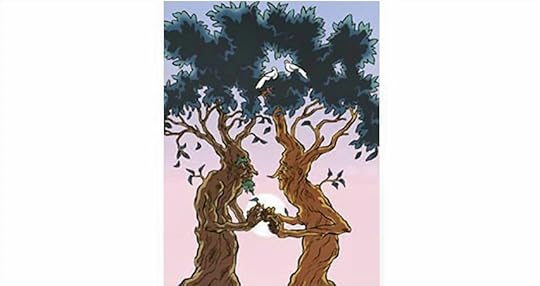
 Thanks to all who have commented so far. I am still tied up on another project, but the assurance that this scene is intended as literary commentary or even parody greatly reduces my apprehension. R.
Thanks to all who have commented so far. I am still tied up on another project, but the assurance that this scene is intended as literary commentary or even parody greatly reduces my apprehension. R.
 PERSEUS/ANDROMEDA SCULPTURES. What a splendidly tactile thing the subject of Perseus and Andromeda can be, when executed in three dimensions, and what a range it gives for the drama of the event! I offer four (plus a couple of details).
PERSEUS/ANDROMEDA SCULPTURES. What a splendidly tactile thing the subject of Perseus and Andromeda can be, when executed in three dimensions, and what a range it gives for the drama of the event! I offer four (plus a couple of details). Two from France. This big group by Pierre Puget (1620-94) was designed originally for Versailles. It is full of energy, as Perseus reaches high to undo Andromeda's bonds, allowing her to curl into his lap. By contrast, the version by Joseph Chinard (1756–1813) avoids all the preceding drama, and expresses only tenderness and love.

Puget: Perseus and Andromeda (1684, Louvre)
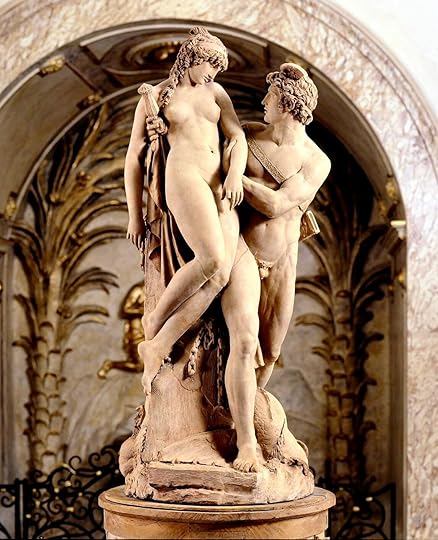
Chinard: Perseus Freeing Andromeda (1791, Lyon)
And two from Victorian England, both of which interest me for their unusual composition and dramatic intensity. The Perseus and Adromeda fountain in the gardens of the now-gutted Witley Court in Worcestershire, laid out by William Andrews Nesfield (1793-1881) as an English Versailles, was executed by the sculptor William Forsyth (1833–1915). Andromeda seems to have been untied already, but what a magnificent monster! Because of its setting in in front of the light stone of the Tate Gallery in London, the bronze by Henry C. Fehr (1867–1940) must be hard to photograph, but I add two details: one of Perseus with the surprisingly beautiful Medusa's head, the other of Andromeda almost crushed beneath the monster's body.

Nesfield and Forsyth: Perseus and Andromeda fountain (1850s, Witley Court)

Fehr: The Rescue of Andromeda (1893, Tate)
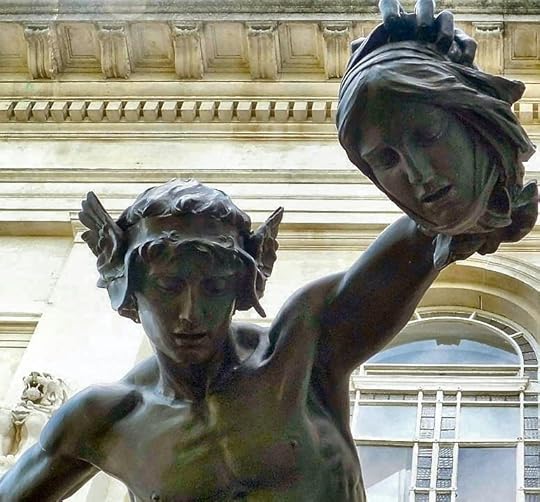
— detail of the above

— detail of the above
 Kalliope wrote: "My favourite Atlas.. the one inside the Amsterdam Palace, former Town Hall."
Kalliope wrote: "My favourite Atlas.. the one inside the Amsterdam Palace, former Town Hall."Nice, Kalliope! It took a surprising amount of looking to find out the sculptor, Artus Quellinus the Elder (1609–68), and the date: 1650–65. But the search turned up a dividend: this relief of Argus, Io, and Mercury, also from the palace:
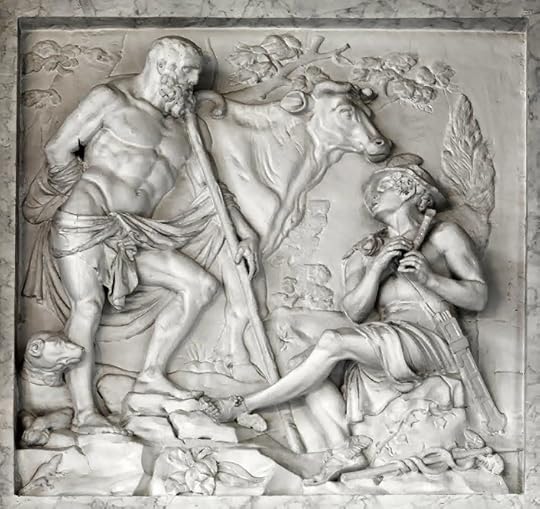
Quellinus: Argus, Io, and Mercury (1655, Amsterdam, Royal Palace)
 Kalliope wrote: "Encountered this tool... One can look up any character..."
Kalliope wrote: "Encountered this tool... One can look up any character..."Indeed, and I've been using it. But it's not visually atractive, and its completeness is daunting. R.
 Tomorrow or the next day, probably, I will complete my index for Book IV and start the story and character breakdown for Book V. So if you, Kalliope, or anybody else has more to post on Book IV, then keep it coming!
Tomorrow or the next day, probably, I will complete my index for Book IV and start the story and character breakdown for Book V. So if you, Kalliope, or anybody else has more to post on Book IV, then keep it coming!I must confess, though, to a lack of appetite for getting into Book V, because that opening scene with all the slaughter just seems so crude. Perhaps a careful reading will prove me wrong; it will at least get me past it. R.
 Thanks, RC. I didn't know that the Ariosto episode was so closely related to the Andromeda myth, but of course it is. The only significant difference is that the hero rides in on a hippogriff rather than Pegasus or his own winged sandals.
Thanks, RC. I didn't know that the Ariosto episode was so closely related to the Andromeda myth, but of course it is. The only significant difference is that the hero rides in on a hippogriff rather than Pegasus or his own winged sandals.Pursuing this, I also came across an illustration of the same Ariosto scene by the Swiss painter Arnold Böcklin (1827–1901). It is a rather tamer version, apparently transferred to land, with Ruggiero riding a normal horse, and Angelica tied to a tree—more like St. George and the Dragon; it seems this is a common trope. But I like the rather cute dragon, who seems protective of Angelica rather than imminently carnivorous!

Böcklin: Roger Freeing Angelica (1873, Berlin)
Your question about Atlas relates to something I mentioned in an earlier post. He seems to have at least two quite distinct stories: the one involving Perseus, as told by Ovid, and what I would have thought was the more basic one, that he was a Titan whom Zeus condemned to hold up the heavens after the Olympians' overthrow of the entire race. So further confusions are only to be expected. R.
 Here it is. A group of Mars and Venus in the Louvre, with Mars a portrait of the Emperor Hadrian and the Venus later reworked as a portrait of somebody else. It is not so odd when you see the close-up, where the moustache is part of a complete beard. But in a smaller picture, where you hardly see the short beard, the moustache makes him look like an officer from WW1! R.
Here it is. A group of Mars and Venus in the Louvre, with Mars a portrait of the Emperor Hadrian and the Venus later reworked as a portrait of somebody else. It is not so odd when you see the close-up, where the moustache is part of a complete beard. But in a smaller picture, where you hardly see the short beard, the moustache makes him look like an officer from WW1! R.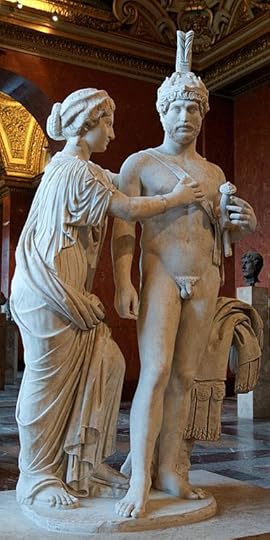
Roman: Mars and Venus (120–140, Louvre)

— detail of the above
 Kalliope wrote: "But that is precisely the point, the handling of Apollo is different, on purpose.. Vz is contra..."
Kalliope wrote: "But that is precisely the point, the handling of Apollo is different, on purpose.. Vz is contra..."You and I seldom allow ourselves to agree with one another on matters of art, but I grant you the inside track on your often puzzling compatriot. And on the matter of his Mars, there is no disagreement at all: the painting is absolutely superb.
Somewhere quite recently I saw a sculpture bust of, I think, one of the Roman Emperors with just such a moustache, though a little smaller. It was something I noticed with surprise in passing, but not enough to save the image. R.
P.S. I found it, and will post it in a minute or two.
 Kalliope wrote: "I shall post another one in which he mixes in a funny way the various realms, and since it is Bacchus, it is appropriate for this thread."
Kalliope wrote: "I shall post another one in which he mixes in a funny way the various realms, and since it is Bacchus, it is appropriate for this thread."Oh, utterly appropriate. And very well-known. Here, the contrast between the mythological and genre elements is utterly clear, so it illuminates the Vulcan piece in retrospect, and throws some sidelight on Las Meniñas, which you have already explored.
But I still hold to my criticism, which was not about the unity of composition so much as comparative weakness of handling. Bacchus here is fully rounded, fully grounded—of a different substance from his drinking companions, yes, but still entirely real. Can you honestly say that of Apollo? R.

